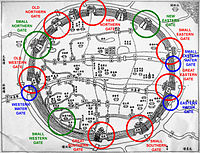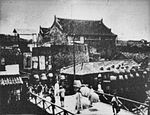- Old City of Shanghai
-
The Old City of Shanghai (Chinese: 上海古城; pinyin: Shànghăi Gùchéng) refers to the most ancient area of Shanghai. It is circular in shape even today, and used to be surrounded by a defensive wall. Notable features include the City God Temple which is located in the center of the Old City and is connected to the Yuyuan Garden. Today, most of the walls have been replaced by broad circular avenues, the Renmin Lu to the North and Zhonghua Lu to the South.
Contents
Fortifications
An original city wall dating back to the 11th century surrounded the ancient city of Shanghai.[1] The city wall, parts of which remain to this day, was built in 1554, in order to protect the town from raids by Japanese pirates. It measured 10 metres high and 5 kilometres in circumference.[2]
There were originally 6 gates built into the structure, and 3 water gates:
Gates of the Old City of Shanghai Old City maps Gate Images 
Map of Shanghai
in Shanghai Xianzhi.

Map of Shanghai
(made in 1553).

Map of Shanghai
(made circa 1860)

Map of Shanghai
(made circa 1860)
Red: Old gates.
Blue: Water gates.
Green: New gates (1909)Small Northern Gate (小北門 or 拱辰門) (built 1909) 
Old Northern Gate 老北門
also: 晏海門 "Gate of the Peaceful Sea"

New Northern Gate 新北門 (built 1860)
also: 障川門

New Eastern Gate (新東門, 福佑門) (built 1909) Small Eastern Gate 小東門
also: 宝帯門 "Gate of the Diamond Belt"

Small Eastern Water Gate 小東門水門
also: 小東門處跨方浜

Great Eastern Gate 大東門
also: 朝宗門 "Gate of Dynastic Ancestors"
Eastern Water Gate 東門水門 
Small Southern Gate 小南門
also: 朝陽門 "Gate of the Rising Sun"
Great Southern Gate 大南門
also: 跨龍門 "Gate of the Leaping Dragon"
Small Western Gate (小西門 or 尚文門) (built 1909) Western Water Gate 西門水門
also: 西門跨肇嘉浜
Old Western Gate Laoximen 老西門
also: 儀鳳門 "Gate of the Virtuous Phoenix"

A protective moat surrounded the wall, 20 meters large and 6 meters deep, which was accessed though 3 "Water Gates" (two in the east, one in the west).[3]In 1860 a new gate was created, the "New Northern Gate" (新北門 or 障川門). In 1909, three new gates were pierced:
- the Small Western Gate (小西門 or 尚文門)
- the Small Northern Gate (小北門 or 拱辰門)
- the New Eastern Gate (新東門, 福佑門).[3]
-
The walled city of Shanghai during the Ming Dynasty.
Old City and Foreign Concessions
The Old City remained in place, while new urban areas were being developed on the outskirt though Concessions after the Opium War in 1842.[2] The Old City remained, and was known as the "Chinese City", while the Concessions were named "Northern City" (北城), where only foreigners could live.[1] During the period of Concessions, numerous Chinese lived in packed conditions in the Old City, which functioned as a sort of ghetto.[1]
During the Taiping Rebellion in 1853, the Old City was captured by the forces of the Small Swords Society. The Governor of Shanghai Wu Jianzhang fled to the British Concession and had to transfer control of trade to the foreigners in exchange for help in retaking the city.[4] Also, after 1854, the Chinese were allowed to live outside of the Old City and could settle in the Foreign Concessions.
Destruction of the wall
The Old City walls were dismantled in 1912 by General Chen Qimei, then new Governor of Shanghai.[1][5] Today only a very small portion remains, which has been transformed into a museum, the Dàjìng Gé Pavillon (上海古城墙和大境阁).
Today
Today the Old City contains some ancient but renovated features, such as the Yuyuan Garden complex, and the City God Temple.[6] Its circular shape is now imprinted by the surrounded large streets which occupy the space of the former walls, the Renmin Lu to the North and Zhonghua Lu to the South.[1] The Old City has also been cut in the middle North to South by Henan Lu.[1] The Old City is a combination of ancient winding streets, with some modern high-rise buildings progressively encroaching on the older areas.[1]
See also
Notes
- ^ a b c d e f g The Old City 395 "The Old City never formed part of the International Settlement and was known by the foreigners who lived in Shanghai, somewhat contemptuously, as the 'Chinese City'" in Rough guide to China David Leffman, Simon Lewis,Jeremy Atiyah p.395ff [1]
- ^ a b Shanghai on Strike: The Politics of Chinese Labor by Elizabeth Perry p.15 [2]
- ^ a b Dàjìng Gé Pavillon permanent exhibit
- ^ "After the Small Sword Society had captured the old city, Shanghai's governor Wu Jianzhang became a refugee in the British settlement." in A history of modern Shanghai banking Zhaojin Ji p.39 [3]
- ^ The concrete dragon: China's urban revolution and what it means for the world Thomas J. Campanella p.63 [4]
- ^ Frommer's Shanghai by Sharon Owyang p.74
Municipality of Shanghai History • Geography • Politics • Economy • Architecture Administrative divisions County Areas Culture and demographics Attractions Jinjiang Action Park • Nanjing Road • Shanghai Concert Hall • Shanghai Grand Theatre • Shanghai New International Expo Center • Shanghai Zoo • Yuyuan GardenMuseums Parks Places of Worship ChristianOtherSports venues Towers Transport Hongqiao International Airport • Pudong International Airport • Shanghai Metro • Shanghai Public Transportation Card • Maglev Train • Shanghai Railway Station • Shanghai South Railway Station • Hongqiao Railway Station • Trams in Shanghai • Zhangjiang Tram • Shanghai Bus • Trolleybuses in ShanghaiUniversities Major hotels  Category
Category31°13′30″N 121°29′06″E / 31.225°N 121.485°ECoordinates: 31°13′30″N 121°29′06″E / 31.225°N 121.485°E
Categories:
Wikimedia Foundation. 2010.



















